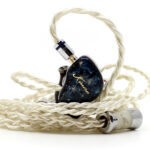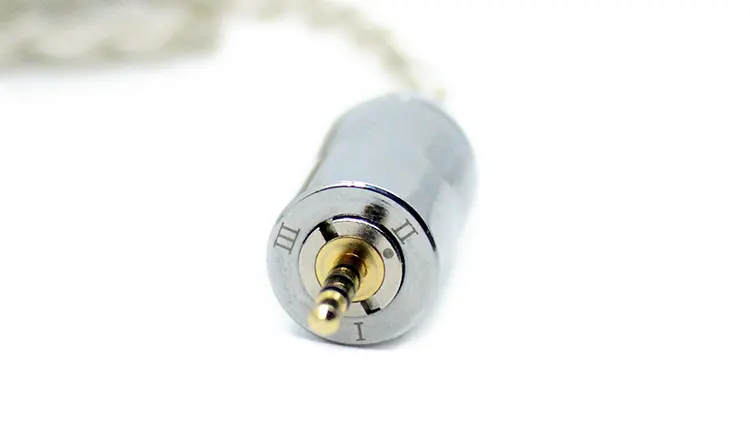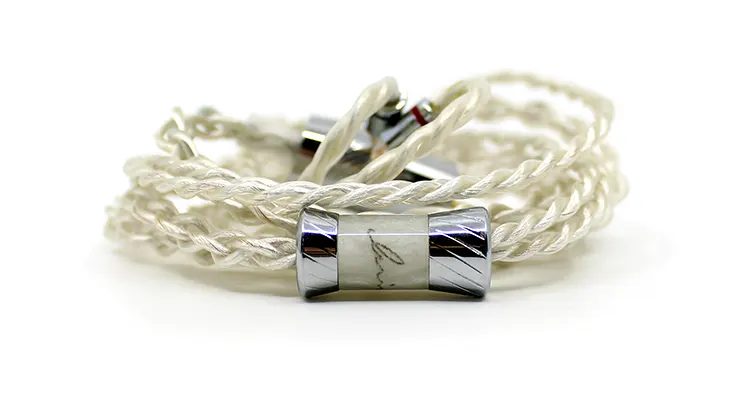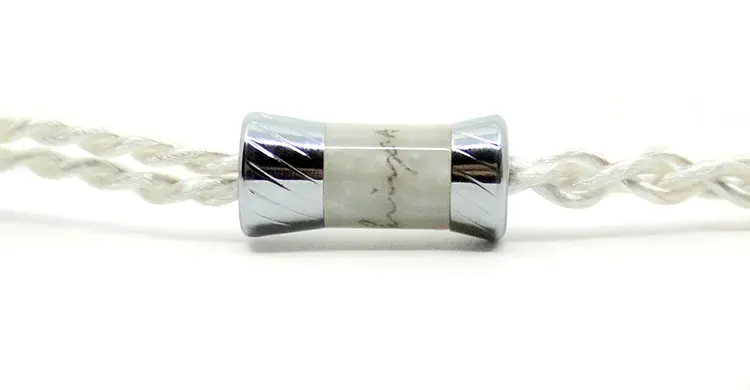We review the Luminox Audio ‘Luminox’, which is a unique tri-coaxial aftermarket IEM cable offering 3 different performances by twisting the jack. It is priced at $1890.
Disclaimer: This is a sample sent in exchange for our honest opinion. Headfonics is an independent website with no affiliate links or status. Thank you to Luminox Audio for this opportunity.
Click here to read more on audio cables that we have previously covered on Headfonics
Note that this article follows our latest scoring guidelines, which you can read up on here.
Hailing from Taiwan, Luminox Audio’s expertise within the audio industry spans 33 years of innovation and aftermarket cable knowledge. Luminox Audio’s flagship cable is named directly after the Company itself and is better known as the ‘Luminox’.
The Luminox cable represents one of the most intriguing cables to date with its highly sophisticated and patented tri-coaxial cable design.
This design has caught the attention of cable enthusiasts and the team at Headfonics as it features a 3-in-1 cable configuration.
But with three different cables in one, does this sonically color the sound as it was intended to or does the over-engineering get the best of it? Read on to find out more.
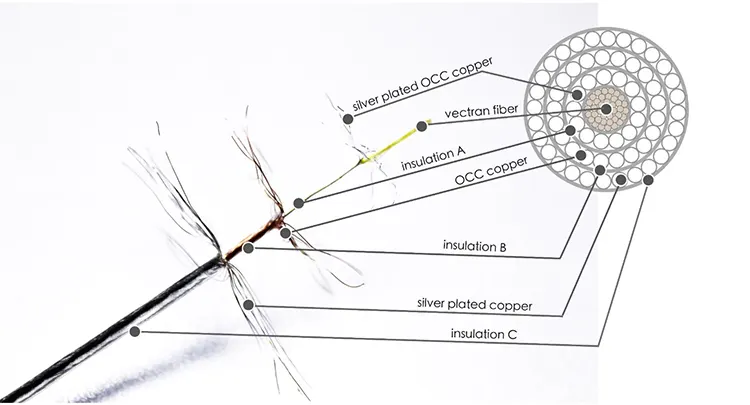
Tech Highlights
Materials
The Luminox cable is one of the most innovative audio cables currently available on the market. Coming in with three different materials, it makes the Luminox the Swiss army knife of cables. But how does it work?
The Luminox is a 4-wire, 21.5 AWG gauge, and a Type-4 Litz aftermarket IEM cable design. Those 3 different materials used are Silver-Plated Ultra-Pure OCC Copper, Silver-Plated OCC Copper mixed with Silver-Plated Copper, and finally, OCC Copper.
The materials do not blend together to make one “coloration” but rather are independently used during operation. Luminox Audio has utilized a special cross-braiding method to ensure that each wire is able to create a stable transmission and minimize sonic distortion given the presence of the different materials being used.
This is an engineering feat as most cable manufacturers’ products come loaded with exotic cable blends or customizable plugs and/or connectors whereas Luminox Audio has brought interchangeable cables to the table. How this is achieved requires a visual representation as shown below.
Within each wire, there are different strands that are built upon each other that surround a Vectran fiber core. These strands are confined into one circular layer and consist of a particular different cable material (e.g., OCC Copper). Each layer is separated by interior insulation which is depicted as insulation A, B, and C.
Switcher
The Luminox cable uses a tri-coaxial plug that allows one to change the cable material being used on the go. By using the “ tuning switcher”, each 120-degree rotation allows a different cable blend to be used.
A small dot underneath the 2-pin plug points towards the Roman numerals I, II, and III and represents the type of cable material being applied: “I” for Silver Plated Ultra-Pure OCC Copper, “II” for Silver-Plated OCC Copper and Silver-Plated Copper and “III” for OCC Copper.
Design
The Luminox uses a combination of white, silver, and pearl-colored tones to create a luxurious and elegant finish. The cable comes in a silver-colored jacket that depending on the lighting, can show an off-white color.
The materials used in the splitter, plug, and connectors are of very high quality and are made of chromium-plated copper which gives it a shiny and silver appearance.
The splitter is shaped like a small barrel that flares out towards the top and bottom. A pearl-white resin with the words “Luminox.A” engraved into it can be found in the middle of the splitter. It is also compact and lightweight making it very ergonomic and comfortable to use.
The connectors have a cylindrical barrel which leads to the 2-pin connectors themselves which come in a small plastic casing. Personally, the plastic casing could have been done without as it disrupts the flow of the white and silver theme of the cable.
The cable plug features a 2.5mm termination which can be easily changed to 4.4mm or 3.5mm with the included ddHiFi adapters.
Given the 3-cable system inside the Luminox, this does limit the natural plug type to 2.5mm only and results in a very large and bulky plug. The plug represents 75% of the cable’s weight but given what is really packed inside, this is totally understandable.
The Luminox cable comes only in a 4-wire configuration where the finish of the braiding and tension within the cable is excellent. The limitation of a 4-wire configuration is a bit of a missed opportunity as having a 6 or 8-wire option would definitely provide more options to the consumer. However, this was probably a limitation of the tri-coaxial design.
Handling & Comfort
The Luminox cable is very lightweight and comfortable to wear during use. Although the weight of the plug is quite substantial, it is located at the end of the cable which is connected to the source, and hence has little impact on the overall comfort and rather impacts its transportability.
The splitter is lightweight but provides enough tension to allow the cable to fall comfortably during use.
One noticeable element that was missing was a cable cinch. The missing cable cinch does impact on the overall comfort especially if you are listening to music and moving at the same time.
Packaging & Accessories
The Luminox is the flagship cable of the Company and boy they did not disappoint with the packaging.
The Luminox comes packaged in a massive cube that has a solid, black metal finish. The box itself feels like it was built to withstand the meanest of drop tests and anything that was thrown at it.
To add that extra level of safety, there are rubberized edges and corners. The logo “Luminox.A” can be found in white writing at the top of the lid. At the front of the box, there is a black metal clip that can be locked with the included set of keys.
As you open the lid, you are met with a Van Nuys leather case which has two buttons for the enclosure. The case itself is made out of soft black leather which has a very supple feeling.
White exterior stitches can be found along the edges and the “Luminox.A” logo is embossed on the front. The case is of very high quality and suitably matches the elegant theme of the cable.
The cable itself can be found inside the Van Nuys case. As you dig deeper into the box, you will find a generous amount of 2.5mm to 4.4mm and 2.5mm to 2.5mm DD Hi-Fi adapters, a warranty card, instruction information, and a set of keys.
The “Switches” are very small and can be easy to lose but luckily, Luminox has included 2 additional “switchers” to get you covered.
Performance Impressions
The following impressions were created using the Empire Ears Odin and the Kinera Imperial Loki IEMs along with the Cayin N8ii as the main audio source.
Summary
The following performance summary is probably the most interesting yet on Headfonics as we decipher through 3 different timbres and cable materials from 1 cable.
To recap, we are dealing with 3 cable materials: Indicator “I” for Silver Plated Ultra-Pure OCC Copper (Cable I), indicator “II” for Silver-Plated OCC Copper and Silver-Plated Copper (Cable II), and indicator “III” for OCC Copper (Cable III).
Taking a step back, it is important to note that the differences between Cables I, II, and III are related to the use or absence of silver plating, the purity level of the copper, and the combination of these materials. Now, let us take a deeper dive into each one.
Cable I: Silver-plated Ultra-Pure OCC Copper
The first cable material of Silver-plated Ultra-pure OCC Copper focuses on improving mid-bass texture and coloring the mid-range. Sub-bass depth and reverb reduces and there is a similar effect on the mid-bass as it becomes less prominent with reduced slam. Instead, the bass becomes punchier with better control and faster decay.
Mid-bass texture improves, and you get a better sense of the quality of bass notes. Mid-range is the forte of cable I where the overall resolution of the mid-range improves. Female vocals sound lush, smooth, and organic.
Cable I pulls back the upper mid-range and pushes the lower mid-range forward, resulting in a more linear presentation of the mid-range. Cable I brings a warm timbre with it. Treble is where the coloration tapers off resulting in a somewhat relaxed or neutral treble presentation with decent extension and hence minimal change.
Soundstage is stretched wider however depth and height do not change significantly. As a result, the stage has the most space horizontally. Imaging improves as a result of this but not by a large margin.
Cable II: Silver-Plated OCC Copper
Cable II has the most “engaging” coloration of the three cables. It colors all sonic frequencies in diverse ways which ensures that the sound becomes more energetic whilst being highly detailed.
Let us start with the bass frequencies where the sub-bass digs deeper and there is an increased amount of reverb. Mid-bass gains more forwardness with increased amounts of slam however there is now slower decay. Mid-bass texture improves and there is a noticeable step up in texture and resolution.
The lower and center mid-range becomes more forward where instruments and vocals become the focal point. The upper mid-range does pull itself back slightly. Piano keys are being pressed, violins are being strung, and male and female vocals sound very lush and smooth. Aside from the improved resolution of the mid-range, cable II does have a slightly warm timbre.
The cable I’s timbre does have more warmth compared to cable II. Treble energy increases a notch or two where it is presented with more sparkle.
Treble extension improves and so does the resolution and clarity. High hats come off with that extra zing and sound very detailed.
Soundstage width expands along with the depth and height. It is not the widest, tallest, or deepest expansion but it gives you a hint of 3D-esque soundstage. Cable II has the most expansive soundstage of all three cables.
As a result, imaging improves drastically and there is a better sense of positioning and accuracy with regards to the placement of instruments and vocals across the stage.
Cable III: OCC Copper
The third and last cable features OCC Copper only and ditches the silver plating seen on the other 2 cables.
As a result, Cable III focuses on coloring the mid-bass and mid-range. Sub-bass digs deep with a decent amount of extension and reverb. Mid-bass slam increases and there is a slower decay of bass notes.
Mid-range does come off with a decent level of detail. Like cable II, the lower and center mid-range become more forward with the upper mid-range pulling back.
Cable III has the warmest timbre of the 3 cables where vocals and instruments come off as organic and natural sounding. The treble becomes colored with a hint of sparkle and a decent level of extension and resolution.
Soundstage width and depth do not change significantly and come off with more intimacy. As a result, cable III has the narrowest soundstage of the three cables. Imaging is decent although its capabilities are restricted by the somewhat narrow soundstage.
Click on page 2 below for our pairing performances and our selected comparisons.





